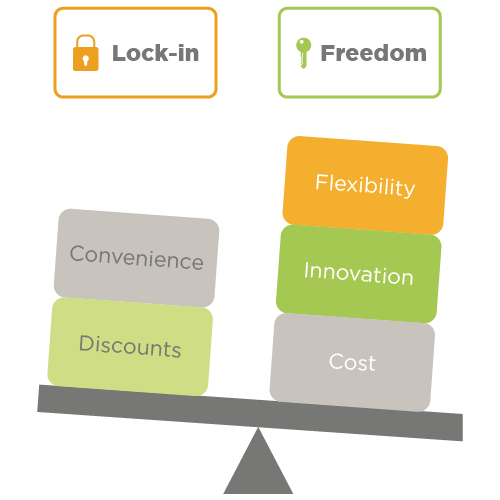How Not to Get Vendor-Locked with Golang Development Services


Creating an application is a process with lots of variables. The first part of it is planning, and the earliest part of planning involves the choice of the platform, toolset, and whether in-house resources or outsourcing will be used. Here we’ll talk about a highly appropriate tool for modern web applications and the common concern – vendor lock-in. The tool in question is the Go language or “Golang,” and the potential problem with Golang development services outsourcing is vendor lock-in.
History and background
The Go language, or Golang, started as an in-depth experiment at Google. Three engineers – Robert Griesemer, Rob Pike, and Ken Thompson – started the project being unsatisfied with the sheer complexity of C++. They wanted their new language to inherit pros from both dynamic and static languages, while not attracting their cons. They wanted it to be statically typed, productive, and easily read, with rich built-in support for multiprocessing, networking, concurrency features, and high scalability for the sake of big systems. There was one more feature designed into Go from scratch – IDEs are not obligatory, though well supported.
As the result of their work, which began back in 2007, Golang’s authors achieved a remarkable language. Though obviously strongly influenced by C in many ways including syntax, Golang has some distinctive features, including a garbage collector.
Advantages
For instance, a combined declaration/initialization operator is present – using type inference it deduces the type of the needed variable from such patterns as: “n:=1”, in contrast with “int n=1;”. Go is also known for its fast compilation and its remote package management.
The initial ideas of Thomson, Pike, and Griesemer for multiprocessing support were realized as a powerful set of out of the box concurrency primitives. Goroutines might be the most famous, though channels are also there. Virtual and non-virtual inheritance are replaced by an interface system and type embedding respectively. Native binaries are statically linked, omitting external dependencies.
Overall, Go’s syntax is more brief, readable, and light in terms of cognitive pressure.
Golang has a powerful built-in toolset, the idea for which was one of the cornerstones for Go’s creation. The concurrency mechanisms of Go enable an exemplary, easy to use way to handle the everyday tasks of event-based web servers, for example. Simply adding the keyword “go” to a function call launches it in a new light-weight thread – a goroutine. As of now, goroutines are handled by multiplexing them into sets of OS threads. Goroutines are instrumental in solving both concurrency issues – CPU multithreading or parallelism – and asynchronous tasks. That might be carrying out slow tasks simultaneously with multiple faster ones, or dedicating a personal goroutine to each client connecting to a server.
Drawbacks
Generics and lack of dynamic language flexibility are the drawbacks usually cited. The first one has at least two responses:
There is another concern, though it is going to be sorted out. Golang has a package system. It can even bring packages from remote sources (GitHub, for instance); the “go get” command is used for this. But this package system is rarely described as a “nice one” or “highly developed,” let alone “exemplary.” Each package must have a path, and third-party developers are encouraged to take measures to avoid name collisions. Many voices have called for the introduction of a new package system into Golang. Something more advanced and effective, often referring to Node’s npm.
Bottom line
Golang is still rather young, so this criticism is both true and anticipated. As are the future improvements that nobody doubts will come. Golang today is not without its issues, but it can quite easily be seen already that Go is a progressive, highly apt tool, especially for web development. It is also backed up by Google, and even though its compiler – gc – is an open source project, Google’s trust in Go and its far reaching plans for the language are obvious. Golang also covers a plethora of platforms, all major ones included. So Golang Development Services outsourcing is a frequent choice – a good one, indeed.
The lock-in concern
Yet, there is a nightmare that often haunts many decision makers in both start-ups and developed businesses – the vendor-lock. This is the IT equivalent of the “putting all your eggs in one basket” scenario. So if a company decides to outsource their intended software product, they surely need to hire Golang developers. There are lots of firms offering Go development services, and nobody can either know them all, or know any well, if they are new to the market. That is why the question of trust often arises when outsourcing is concerned. And while the legal field covers most trust problems with strict contracts etc., there are issues that have an even bigger impact and higher risks.

A big project outsourced to a single developer ties the customer to the contractor, making the former rely on the latter for everything. All steps of the project now fall in one pair of hands with little to no guarantee of successfully overcoming any difficulties. Legacy support is in question in both directions: both implementing support for previous product versions or older products developed by another vendor, and potential future issues with compatibility in the event that the vendor is changed again.
There is also a certain lack of flexibility in such an approach. Big projects can be complicated, and the hired Go developers might have they own views, or there may just be uneven teams for different parts of the bigger whole. Things can get really messy this way. Another frequent mishap: the chosen vendor does not have enough Go development expertise for some specific part of the ordered project, or it just falls out of the schedule, so the vendor hires a subcontractor. While not being necessarily a bad thing in itself, this scenario has one serious drawback – the original customer has no control over that part of the project from that moment.
All this, and many more issues besides, brings up the classical description of vendor or proprietary lock-in from economics – being a set of actions preventing customers from changing vendors by raising switching costs to substantial levels. While monopolistic lock-ins are virtually unavoidable, due to costs, in the case of Golang development services, there is a modern way to avoid those mishaps. This once again brings up Go’s design.
Avoiding vendor lock-in
Modularity – that’s the key. Golang does a great job in modularizing big projects. Debugging is superbly easy, due to the predictability of Go’s syntax and structure, plus there is the famous “go fmt” tool, which automatically formats Golang code to agreed specifications.
The ability to directly import packages also adds to Golang’s abilities for modular work. Let’s not forget, Go was conceived with a consideration of networking, so it has a number of highly useful built-in tools for this, security included:
- Cryptography libraries (RSA, AES, crypto-safe random number generator)
- Secure web protocols (TLS, SSL)
- HTTP server (w/ HTML templates)
Now it is clear that a big project in Golang could be easily divided into a number of smaller modules, and those would meld seamlessly into a proper full product, rather than a pile of parts glued together with superglue and nails. Each individual part can be delegated to a separate vendor that suits the specific solution best, and the only hands that are across the whole project are those of the assembly vendor (optional) and the original customer. The flexibility of this solution is unparalleled, and the gain is obvious – no vendor lock-ins for the project overall: any module could be transferred to a new vendor far more easily than the whole project; precise, clear and direct control over any desired part of the project is in the original customer’s hands at any time. Now the customer company can concentrate on their business logic and have a highly comprehensible road map. There is one more thing – as Golang itself is designed for multiprocessing, projects properly divided into modules and granted to a number of independent teams tend to grow faster, due to the multitasking approach.
Golang has walked a path from being the fastest language in popularity growth in its initial year, when it hit #13 in the TIOBE rating 2010, falling down significantly (lower than #50) in 2015, and finally rising up again to the familiar #13 spot right now. Go has proved to be a fine tool with a great future. It has the enormous backup from its parent company, the mighty Google, and being open-source and cross-platform, Golang has a multinational army of users, supporters, and developers. All of which makes for a great community. Golang also has native support for microservice architecture, which has an army of its own, providing vast third-party support – GoKit, for instance.
So if you are a decision maker for either a big and established or a small and fresh company, seeking to avoid vendor lock-in for your outsourced project, Golang’s goodness is here for your service. Use a series of vendors instead of one, get direct control over each project part, get the job done faster via parallel work, and migrate modules with minimal to no cost. This is the modern world, and this is the modern way.
Want to get the most out of your solution but lack the required resources of time and skills? Let us take a look at your project. Our skilled IT ninjas will get you just the thing you want in no time. Contact us via email – [email protected] or by phone – +38 044 592 50 87(Ukraine)/971 940 6823 & 321 328 8379 (USA).